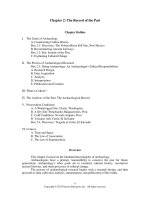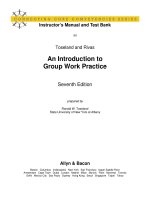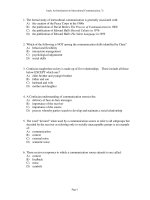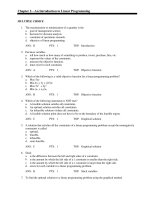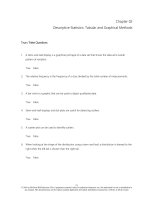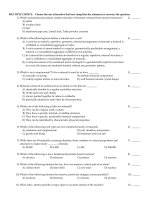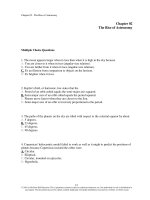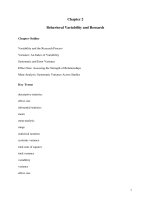An introduction to group work practice 7th edition toseland test bank
Bạn đang xem bản rút gọn của tài liệu. Xem và tải ngay bản đầy đủ của tài liệu tại đây (324.17 KB, 32 trang )
Instructor’s Manual and Test Bank
for
Toseland and Rivas
An Introduction to
Group Work Practice
Seventh Edition
prepared by
Ronald W. Toseland
State University of New York at Albany
Allyn & Bacon
Boston Columbus Indianapolis New York San Francisco Upper Saddle River
Amsterdam Cape Town Dubai London Madrid Milan Munich Paris Montreal Toronto
Delhi Mexico City Sao Paulo Sydney Hong Kong Seoul Singapore Taipei Tokyo
Copyright © 2012, 2009, 2005 Pearson Education, Inc., publishing as Allyn & Bacon, One Lake Street,
Upper Saddle River, NJ 07458. All rights reserved. Manufactured in the United States of America. The
contents, or parts thereof, may be reproduced with An Introduction to Group Work Practice, Seventh
Edition by Ronald W. Toseland and Robert F. Rivas, provided such reproductions bear copyright notice,
but may not be reproduced in any form for any other purpose without written permission from the
copyright owner. To obtain permission(s) to use material from this work, please submit a written request
to Pearson Education, Inc., Permissions Department, 501 Boylston Street, Suite 900, Boston, MA 02116,
or fax your request to 617-671-3447
10 9 8 7 6 5 4 3 2 1
15 14 13 12 11
:
www.pearsonhighered.com
ISBN-10: 0-205-82009-3
ISBN-13: 978-0-205-82009-2
CONTENTS
Current Listing of Supplements Associated with
Connecting Core Competencies Series Titles
v
CSWE’s Core Competencies Practice Behaviors Coverage in this Text
vii
Sample Syllabus
ix
Chapter 1
Introduction
1
Chapter 2
Historical Developments
15
Chapter 3
Understanding Group Dynamics
27
Chapter 4
Leadership
39
Chapter 5
Leadership and Diversity
53
Chapter 6
Planning the Group
64
Chapter 7
The Group Begins
77
Chapter 8
Assessment
89
Chapter 9
Treatment Groups: Foundation Methods
102
Chapter 10
Treatment Groups: Specialized Methods
115
Chapter 11
Task Groups: Foundation Methods
129
Chapter 12
Task Groups: Specialized Methods
142
Chapter 13
Ending the Group’s Work
155
Chapter 14
Evaluation
168
Appendix
Assess Your Competence (by chapter)
180
© 2012 Pearson Education, Inc. All Rights Reserved.
iii
Current Listing of Supplements Associated With
Connecting Core Competencies Series Titles
IM TB PPTs MyTest
Assess
Yourself
© 2012
Farley/Smith/Boyle
Introduction to Social Work, 12e
Morales/Sheafor/Scott
Intro
Social Work, Updated 12e
DiNitto/Johnson
Policy
Social Welfare, Brief 1e
Stern/Axinn
History
Social Welfare, 8e
Generalist Cummins/Sevel/Pedrick
Practice Social Work Skills Demonstrated, 3e
Group
Toseland
Practice An Introduction to Group Work Practice, 7e
Macro
Netting/Kettner/McMurty/Thomas
Practice Social Work Macro Practice, 5e
Maschi/Youdin
Research
Practitioner as Researcher, 1e
Yegidis/Weinbach/Meyers
Research
Research Methods for Social Workers, 7e
Matich‐Maroney
Field
The EPracticum Companion
Royse/Dhopper/Rompf
Field
Field Instruction, Updated 6e
© 2011
DuBois/Miley
Intro
Social Work, 7e
Marx/Broussard/Hopper/Worster
Intro
Social Work and Social Welfare, 1e
Popple/Leighninger
Intro
Social Work, Social Welfare, and American Society, 8e
Cummins/Byers/Pedrick
Policy
Policy Practice for Social Workers, Updated 1e
Popple/Leighninger
Policy
The Policy Based Profession, 5e
Generalist Miley/O’Melia/DuBois
Practice Generalist Social Work Practice, Updated 6e
Schriver
HBSE
Human Behavior and the Social Environment, 5e
Dudley
Research
Research Methods for Social Work, Updated 2e
Birkenmaier/Berg‐Weger
Field
The Practicum Companion, 3e
Garthwait
Field
The Social Work Practicum, 5e
Intro
3 3
3
3
3
3 3
3
3
3
3 3
3
3
3
3 3
3
3
3
3 3
3
3
3
3 3
3
3
3 3
3
3
3 3
3
3
3
3
3
3
3
3 3
3
3
3
3 3
3
3
3
3 3
3
3
3
3 3
3
3
3
3 3
3
3
3 3
3
3
3
3 3
3
3
3
3 3
3
3
3
3
3
3
© 2012, Pearson Education, Inc. All Rights Reserved.
v
MySocialWorkLab is a dynamic website offered with every Connecting Core Competencies
Series text providing a wealth of resources geared to help students develop and master the skills
articulated in CSWE’s core competencies—and improve their grades in their Social Work
courses.
MySocialWorkLab is available at NO EXTRA COST when bundled with any text in the
Connecting Core Competency Series.
Would you like to assign a workbook that assesses student
mastery of CSWE’s core competencies?
Would you like to use MySocialWorkLab – with cases, videos,
assessment, and much more – in ALL the courses you teach?
Offered in both printed workbook and MySocialWorkLab website
versions, Nichols, Connecting Core Competencies: A Workbook for
Social Work Students contains 300+ assessment questions that test
student mastery of the core competencies plus explanations of each
competency.
Printed Workbook version:
Each chapter covers one of CSWE’s 10 core competencies and includes:
• A detailed explanation of the competency
• Assessment questions that test student knowledge and mastery of the skills in the
competency with multiple choice, short case vignette questions, and reflective essay
questions. And, many are written in a format similar to the questions on the licensing
exam.
• Bundle option to package to MySocialWorkLab version at no extra charge.
MySocialWorkLab version:
• A complete eText of the workbook (see above) with chapter quizzes
• Over 50 Videos illustrating CSWEs Core Competencies with assessment
• MySocialWorkLibrary with of over 75 cases with assessment
• Assessment that feeds into your Gradebook
• And more
MySocialWorkLab can be bundled at no extra charge with any Pearson text; the printed version
is available for $5 when bundled with any Pearson text. Also available standalone.
For more information, visit: />© 2012, Pearson Education, Inc. All Rights Reserved.
vi
CSWE’s Core Competencies Practice Behaviors Coverage in this Text
Practice Behavior
Chapter
Professional Identity (2.1.1)
Social workers advocate for client access to the services of social work;
Social workers practice personal reflection and self-correction to assure continual
professional development;
Social workers attend to professional roles and boundaries;
Social workers demonstrate professional demeanor in behavior, appearance, and
communication;
Social workers engage in career-long learning;
Social workers use supervision and consultation.
1, 5, 9, 10, 12
1, 3, 4, 5, 14
1, 2, 3, 4, 5, 9, 10, 11
1, 4, 5
4
4
Ethical Practice (2.1.2)
Social workers recognize and manage personal values in a way that allows
professional values to guide practice
Social workers make ethical decisions by applying standards of the National
Association of Social Workers Code of Ethics and, as applicable, of the
International Federation of Social Workers/International Association of Schools of
Social Work Ethics in Social Work, Statement of Principles
Social workers tolerate ambiguity in resolving ethical conflicts
Social workers apply strategies of ethical reasoning to arrive at principled
decisions
1, 4, 5, Appendix 1, 2, 3
1, Appendix 1, 2, 3
1, 7, Appendix 1, 2, 3
1, Appendix 1, 2, 3
Critical Thinking (2.1.3)
Social workers distinguish, appraise, and integrate multiple sources of knowledge,
including research-based knowledge, and practice wisdom
Social workers analyze models of assessment, prevention, intervention, and
evaluation
Social workers demonstrate effective oral and written communication in working
with individuals, families, groups, organizations, communities, and colleagues
1, 2, 3, 4
1, 2, 8, 9, 10, 11, 12, 14
6, 7, 14
Diversity in Practice (2.1.4)
Social workers recognize the extent to which a culture’s structures and values may
oppress, marginalize, alienate, or create or enhance privilege and power
Social workers gain sufficient self-awareness to eliminate the influence of personal
biases and values in working with diverse groups
Social workers recognize and communicate their understanding of the importance
of difference in shaping life experiences
Social workers view themselves as learners and engage those with whom they
work as informants
3, 5
1, 3, 4, 5
1, 3, 4, 5
3, 4, 5
Human Rights & Justice (2.1.5)
Social workers understand the forms and mechanisms of oppression and
discrimination
Social workers advocate for human rights and social and economic justice
Social workers engage in practices that advance social and economic justice
© 2012 Pearson Education, Inc. All Rights Reserved.
vii
1, 5, Appendix 1, 2, 3
1, 5, 12
1, 5, 12
CSWE’s Core Competencies Practice Behaviors Coverage in this Text
Practice Behavior
Chapter
Research Based Practice (2.1.6)
Social workers use practice experience to inform scientific inquiry
Social workers use research evidence to inform practice
1,
9,
1,
9,
2, 3, 4, 5, 6, 7, 8,
10, 11, 12, 13, 14
2, 3, 4, 5, 6, 7, 8,
10, 11, 12, 13, 14
Human Behavior (2.1.7)
Social workers utilize conceptual frameworks to guide the processes of
assessment, intervention, and evaluation
Social workers critique and apply knowledge to understand person and
environment.
2, 4, 5, 9, 10, 13
1, 2, 3, 4, 5, 6, 7, 8,
9, 10, 11, 12, 13, 14
Policy Practice (2.1.8)
Social workers analyze, formulate, and advocate for policies that advance social
well-being
Social workers collaborate with colleagues and clients for effective policy action
1, 2, 10, 12, 14
1, 2, 10, 12, 14
Practice Contexts (2.1.9)
Social workers continuously discover, appraise, and attend to changing locales,
populations, scientific and technological developments, and emerging societal
trends to provide relevant services
Social workers provide leadership in promoting sustainable changes in service
delivery and practice to improve the quality of social services
3, 4, 5, 6, 7, 8, 9, 10,
11, 12
2, 4, 11, 12, 14
Engage, Assess Intervene, Evaluate (2.1.10 (a)–(d))
A) ENGAGEMENT
Social workers substantively and effectively prepare for action with individuals,
families, groups, organizations, and communities
Social workers use empathy and other interpersonal skills
Social workers develop a mutually agreed-on focus of work and desired outcomes
B) ASSESSMENT
Social workers collect, organize, and interpret client data
Social workers assess client strengths and limitations
Social workers develop mutually agreed-on intervention goals and objectives
Social workers select appropriate intervention strategies
C) INTERVENTION
Social workers initiate actions to achieve organizational goals
Social workers implement prevention interventions that enhance client capacities
Social workers help clients resolve problems
Social workers negotiate, mediate, and advocate for clients
Social workers facilitate transitions and endings
D) EVALUATION
Social workers critically analyze, monitor, and evaluate interventions
© 2012 Pearson Education, Inc. All Rights Reserved.
viii
6, 7, 8
3, 4, 5, 6, 7, 8, 9, 10,
11, 13
4, 6, 7
8, 9, 10, 11, 12, 14
1, 8,
6, 7,
8, 9,
2, 6,
12
7, 9,
2, 7,
2, 7,
13
14
9, 10, 11, 12
8
10, 11, 12, 13
7, 8, 9, 10, 11,
10, 11, 12
9, 10, 11, 12, 13
11, 12
SAMPLE SYLLABUS
[INSERT UNIVERSITY NAME HERE]
[INSERT COURSE NAME HERE]
[INSERT COURSE NUMBER HERE]
Professor:
Office Number/Location:
Office Hours:
Professor Phone:
Professor Email:
Course Meeting Times:
COURSE DESCRIPTION
This is an introductory course in group work practice. Its objective is to teach students the knowledge
and practice skills which are necessary for group work practice. The course emphasizes basic theory
about groups and group process, demonstrates the skills necessary for effective practice, and gives
students the opportunity to discuss and practice these skills. In addition, the course is designed to
acquaint students with the many uses of task and treatment groups in a broad range of settings with
diverse client groups.
COURSE OBJECTIVES
•
•
•
•
•
•
•
•
•
To educate generalist social workers to have the tools to work in various settings with a variety
of client groups, addressing a range of personal and social problems and using skills to intervene
at practice levels ranging from the individual to the community.
Understanding of the historical and the current use of groups in social work practice.
Ability to understand, assess, and use group properties and group processes occurring in a group.
Ability to understand and work with diversity in groups.
Ability to assess the need for a group.
Ability to plan for, begin, and conduct a group.
Understanding of and ability to use group processes to achieve the goals and
objectives of the group.
Ability to evaluate the outcome of a group and to use the information to improve
group practice.
Knowledge about resources available to plan for and establish specific treatment and
task groups which may be needed in specialized fields of practice and in specific
social work settings.
STUDENT LEARNING OBJECTIVES/OUTCOMES
In this course, didactic material will be presented in lecture and through homework assignments. This
material will expose the student to different approaches to group work. The emphasis will be on
developing generic skills, and the differential uses of specific skills for particular problems which are
frequently experienced in treatment and task groups.
REQUIRED TEXT(S)
Toseland, R., & Rivas, R. (2011). An Introduction to Group Work Practice (6th Ed.). Boston: Allyn and Bacon.
© 2012 Pearson Education, Inc. All Rights Reserved.
ix
ASSIGNMENTS AND EVALUATION
Below, you will find the grading scale and percentages.
Grading/Evaluation
Assignment
Class Participation
Midterm
Final
Major Assignment(s):
Midterm Assignment
Presentation Assignment
Final Assignmnet
20%
30%
50%
Letter Equivalent
A – 90-100
B – 80-89
C – 70-79
D – Less than 70
Major Assignments
Midterm Assignment
The mid-term paper is designed to allow you to examine your role in a group. The paper should focus on
explicating group-as-a-whole properties and processes, leadership and the ways in which you interact
with and influence the functioning of the group. I would prefer you to use a current group experience,
but you can use a previous group experience if you are not currently participating in a group. The paper
should be from 10 to 15 pages in length. The paper is not research based. It is an analysis of your
experiences in the group, using the outline for group dynamics covered in lectures and the book, and
your analysis of the leadership of the group.
Outline for the Mid-term Paper
Type of Group: Is the group formed or natural? If formed, is it a treatment or task group and within
that, what type of group is it, i.e. support, socialization etc.?
Communication/Interaction Patterns
a. What are the communication/interaction patterns when the group meets: who talks to whom most
often? Does the interaction vary by time or topic?
b. Are there subgroups or isolates? If yes, what is their basis (what do subgroup members have in
common, e.g., attraction, status, interest, previous acquaintance, etc.) and what effect do they
have on the group?
c. How does the composition (gender, racial or ethnic background, age) affect communication
patterns? For example, are men, Caucasians, older persons, or professionals listened to more?
© 2012 Pearson Education, Inc. All Rights Reserved.
x
Cohesion
a. What brings people into this group -- what do they get out of group membership or what are the
attractions? Examples are prestige, friendship, status with a peer group, chance to make
contacts/meet prestigious people, learn or show off skills, liking of group task or purpose, ethnic
or racial similarities, etc.
b. Does the group appear to be cohesive or highly attractive to its members? What are indicators of
high or low cohesion in this group? Examples of high cohesion are regular attendance, many
members accepting responsibilities, pride in belonging, referring to the group as "we,"
considering the group's (or members') opinion important, choosing to do "group things" when
something else could be done, etc.
c. How does the composition (gender, racial or ethnic background, age) affect cohesion? For
example, do racial/ethnic differences make the group more attractive or less attractive?
Social Integration, Influence and Control (Norms, Roles, Status and Power)
a. What are the norms in this group?
b. What type or range of behavior does the group attempt to control or have expectations about?
For example, are there expectations about dress, topics, attendance, self-disclosure, behavior
outside the group, associates, etc.?
c. What happens to someone who violates the norms?
d. What roles do members play in the group, e.g. gatekeeper, talkative member?
e. Who normally performs task-oriented (maintenance) functions within the group; e.g., keeping
the group on task, coordinating, giving or seeking information, etc.? Other than the leader, do
certain members take on aspects of these functions?
f. Who normally performs socio-emotional (maintenance) functions within the group; e.g.,
encouraging, reducing tension, mediating conflict, making sure everyone is included, etc.? Other
than the leader, do certain members take on aspects of these functions?
g. How do age, gender, and ethnicity or race relate to the member roles? For example, are women
the socio-emotional leaders, men the task leaders? Is the youngest person, or most different
person, usually the "clown" (a socio-emotional role)?
h. Are there differences in status among group members? If so, what are the indicators (cues to
different status)?
i. What are the informal status ranks? Who is "high" and who is "lower?" How does their behavior
differ, for example, amount of talking, initiating interaction, dress, deference to others, freedom
from norms, etc.?
j. What appear to be the bases of higher status, that is, how did "higher status" persons get to be
higher status? Some common methods are prestige, appointed or elected position, status or
expertise outside the group, skills useful to the group (for example, the star athlete on a team,
good writer on a committee to draft a document, good conflict resolver), length of membership,
etc.
k. What are the effects of "non-changeable" characteristics on the status ranks in this group? For
example, are women generally higher or lower status? Someone of a different ethnic or racial
background?
© 2012 Pearson Education, Inc. All Rights Reserved.
xi
l. Has anyone’s status changed over time? If so, why did it happen? For example, did the member
violate norms, learn or contribute new skills, join or leave a subgroup; did the group's purpose or
base of attraction change?
m. Who has the power in the group? Is there a formal and informal leader? Describe the leadership
and what is done well and what could be improved.
Group Culture
a. What are the overall values and beliefs that are displayed in the way the group conducts its
business?
Overall
If you were the leader of the group, name two things that you would try to change about the group
dynamics. Present a plan for how you would try to change the group dynamics. Do the plans for
changing the two dynamics differ? If so, how?
Presentation Assignment
Depending on the size of the class, pick two or three other classmates and decide on a group you would
like to role play. This could be any type of treatment group, ex. anger management, children’s social
skills group etc. Develop roles for other members of the class so that you have a group of 6 to 8
participants. Develop a written agenda for the group meeting, and a second page where you have some
additional resources/references other students could use if they were going to lead such a group. If your
group is not a structured group, develop a 1 or 2 page resource handout which contains information
about the group, what you are trying to accomplish and references from the literature that students could
refer to if they were going to lead this type of group ex. support group, growth group etc. We will use a
fishbowl format where the rest of the class members will sit in a circle around the group you form. This
will not be a graded assignment. It will be pass/fail. If it is not done it will take 10 points away from
your 20 point class participation grade. It is designed to give you a chance to lead a group and to be a
participant in a group. Please sign up for a time slot from session 11 to session 15.
Final Assignment
You have three options for the final paper. The first option is a research paper which is focused on your
work with a group. The second option is for you to plan a group for a specific population (children,
aged, those with substance abuse problems, men who batter, etc.). The third option is for you to do a
paper on group work techniques such as psychodrama, or types of groups (e.g., teams, self-help groups).
The first two options entail reading specialized literature on group work with the population, and
problems faced by the population, and then preparing a paper about the group. In the first option, after a
focused literature review, describe the group and your work with it. For the first option, if you report on
your work with a group you may want to discuss your field experiences, work experiences, or volunteer
experience with a group. The emphasis should be on the leadership of the group, and what you would do
differently based on the course. After the literature review, your description of the group can follow the
planning outline (briefly). Then, you should focus on group dynamics and leadership of the group during
each session, your analysis of the positive and negative aspects of the group dynamics and the
© 2012 Pearson Education, Inc. All Rights Reserved.
xii
leadership, and how it might be lead differently if you have the opportunity to do it again. It is fine if the
group is currently being conducted, and it is not finished. The second option involves planning for a
group that you have never led. If you would rather do this planning option, use the planning group
proposal to illustrate how you would develop and conduct a group with which you have little or no
experience. After the literature review, follow the planning a group option 2 outline on page 7. The
choice of the topic should reflect your interest in a particular area of group work. For the third option,
you need to discuss the topic with me and how you plan to organize the paper. If you are considering the
third option, please make an appointment to see me. For any of the three options be sure to include
information from lecture and from the text for the course. The final paper should be about 15 pages in
length.
Outline for the Final Paper
This is a suggested outline for option one designed to serve as a guide for those who have chosen to
examine their work with a group. Although the outline is fairly comprehensive you are free to vary your
analysis based on the practice situation you are attempting to describe.
1.
2.
3.
4.
5.
Introductory paragraph explaining the paper.
Literature review on the social problem being addressed in the paper.
Literature review on the group work methods that have been used to address the social problem.
Description of the setting and the group.
Planning for the group - See below and the text Chapter 6 (Planning) for topical headings. When
choosing option one, limit your description of planning to one or two pages.
6. Leadership approach used in the group.
7. Intervention strategies used during the beginning, middle and ending phase of the group.
8. Evaluation of the group process - use the group dynamics framework in the text to evaluate
group processes, i.e. communication and interaction, cohesion, social integration dynamics and
culture.
9. Evaluation of the group outcome.
10. Conclusions and recommendations for future practice, and how you would change things if you
were able to do it over.
Final Assignment – Planning a Group (Option 2)
Plan a task or a treatment group for a community social service or health care agency you are familiar
with.
Outline for planning a group:
1. Introductory paragraph explaining the group
2. Purpose: Purpose of the group (its goals)
3. Role of the worker in the group (e.g., chair, facilitator, therapist)
4. Literature review on the social problem being addressed in the paper
5. Literature review on the group work methods that have been used to address the social problem
6. Agency Sponsorship:
Agency name and mission
Agency resources relevant to the group (i.e., physical facilities, financing, staff, etc.)
Agency geographic location (community, not address), sponsorship, demographic
characteristics of clientele, type of staff, any other characteristics that might affect group
© 2012 Pearson Education, Inc. All Rights Reserved.
xiii
7. Membership: Target population for the group—who you would like to reach. Appropriateness of
the population with respect to the agency mission and group purpose.
8. Recruitment: Method(s) for recruiting members.
9. Composition: Criteria for including or excluding members.
10. What characteristics you would like group members to be heterogeneous on, and what
characteristics homogeneous, and why.
Size: Open or closed membership.
Demographic characteristics important to group purpose.
How will the expected composition affect interaction or group development? Include age,
gender, ethnicity/race, sexual orientation, disability or any other special considerations that
may affect the composition.
11. Norms and Roles: What are the most important group norms you would like to develop?
12. How will composition affect the norms or their development? Are there specific roles you would
like members to develop within the group? If so, describe these roles.
13. Orientation: Whether potential members will be screened, and if so, how and for what
characteristics. Preparation for group membership and roles (e.g., pre-group interview or letter,
discussion at beginning of group).
14. Contract: Describe and justify the number of meetings, frequency, length, and times for
meetings. If appropriate, depending on the type of group, describe the types of contracts with
individual group members, or the group as a whole that you would try to foster.
15. Environment: Physical arrangements (room, space, materials, room set-up, other considerations.
Financial arrangements (budget, expense, charges, income) and any special arrangements (child
care, transportation, access for persons with physical handicaps, etc.).
16. Structure: How will the group conduct its work? (e.g., discussion group, arts-and-crafts,
exercises, role plays, etc.). Will there be a structure for each group meeting? How will the
structure help the group achieve its’ goals.
© 2012 Pearson Education, Inc. All Rights Reserved.
xiv
COURSE OUTLINE
Week
Assignment Type
Text Reading:
Chapters 1 & 2
Week 1
Chapter Assignment(s):
Text Reading:
Chapter 3
Week 2
Chapter Assignment(s):
Text Reading:
Chapter 4
Week 3
Chapter Assignment(s):
Text Reading:
Chapter 15
Week 4
Chapter Assignment(s):
Text Reading:
Chapters 5 & 6
Week 5
Chapter Assignment(s):
Text Reading:
Chapter 7
Week 6
Chapter Assignment(s):
Text Reading:
Week 7
Chapter Assignment(s):
Text Reading:
Week 8
Chapter 8
Chapter Assignment(s):
Text Reading:
Week 9
Chapter Assignment(s):
Chapter 9
Mid-term paper due today
© 2012 Pearson Education, Inc. All Rights Reserved.
xv
Text Reading:
Chapters 10
Week 10
Chapter Assignment(s):
Text Reading:
Week 11
Chapter Assignment(s):
Chapter 11
Presentations
Text Reading:
Week 12
Chapter Assignment(s):
Chapter 12
Presentations
Text Reading:
Week 13
Chapter Assignment(s):
Chapter 13
Presentations
Text Reading:
Chapter 14
Week 14
Chapter Assignment(s):
Text Reading:
Final Paper due
Week 15
Chapter Assignment(s):
Text Reading:
Week 16
Chapter Assignment(s):
© 2012 Pearson Education, Inc. All Rights Reserved.
xvi
UNIVERSITY/COLLEGE POLICIES AND ETHICS
[INSTRUCTOR: Insert Your University’s Academic Policies]
© 2012 Pearson Education, Inc. All Rights Reserved.
xvii
CHAPTER 1
Introduction
CHAPTER SUMMARY
This chapter introduces students to social group work practice and provides them with a broad framework
and overview for working with treatment and task groups. The chapter begins with an overview of the
organization of the book and the generalist practice perspective for working with the wide array of groups
professional social workers participate in and lead in community and institutional settings. This is
followed by a description of the historical and current values and ethics that govern social group work
practice. Readers are referred to Appendix A1, A2 and A3 that contain guidelines for ethical group work
practice available from the three major group work associations; the American Group Psychotherapy
Association, the Association for Specialists in Group Work, and the Association for the Advancement of
Social Work with Groups. After presenting a definition of group work practice that is compatible with
generalist social work practice perspective, the chapter distinguishes between formed and natural groups
and treatment and task groups and presents the advantages and disadvantages of working in treatment and
task groups as compared to individual efforts. To illustrate the breadth and depth of social group work
practice the chapter concludes with comprehensive typologies of treatment and task groups.
CSWE COMPETENCIES FOUND IN THIS CHAPTER
Ethical Practice
Research Based Practice
Policy Practice
Engage, Assess, Intervene, Evaluate
LEARNING OBJECTIVES
•
To introduce students to social group work practice
•
To place social group work practice within a generalist practice framework
•
To define social group work practice
•
To distinguish practice with natural and formed groups
•
To highlight that social group work practice encompasses work with both treatment and task groups
•
To contrast the advantages and disadvantages of working with individuals and groups
•
To provide a comprehensive overview of practice with different types of treatment and task groups
© 2012 Pearson Education, Inc. All Rights Reserved.
1
CHAPTER OUTLINE
ORGANIZATION OF THE TEXT
THE FOCUS OF GROUP WORK PRACTICE
Group Work Practice
VALUES AND ETHICS IN GROUP WORK PRACTICE
Practice Values
American Values
Group Work Values
Four Key Values
Practice Ethics
Ethical Principles
DEFINITION OF GROUP WORK
CLASSIFYING GROUPS
Formed and Natural Groups
Purpose and Group Work
Treatment and Task Groups
GROUP VERSUS INDIVIDUAL EFFORTS
Advantages and Disadvantages of Treatment Groups
Advantages of Group Treatment
Advantages and Disadvantages of Task Groups
A TYPOLOGY OF TREATMENT AND TASK GROUPS
Group Work Purposes
TREATMENT GROUPS
Support Groups
Educational Groups
© 2012 Pearson Education, Inc. All Rights Reserved.
2
Growth Groups
Therapy Groups
Socialization Groups
Self-Help Groups
TASK GROUPS
Groups to Meet Client Needs
Teams
Treatment Conferences
Staff Development Groups
Groups to Meet Organizational Needs
Committees
Cabinets
Boards of Directors
Groups to Meet Community Needs
Social Action Groups
Coalitions
Delegate Councils
SUMMARY
TEACHING TIPS
Chapter 1 is designed to give students and overview of social group work practice and to focus on values
and ethics. One of the instructor’s primary goals should be to help social work students place social
group work practice within the broader context of social work practice. It is important to help students to
understand the importance of groups in the formation and maintenance of clients’ identities and how
social group work practice fits within a generalist social work practice perspective. To this end, having
students identify and discuss the influence and impact of their extended family group, ethnic/racial
group, and their participation in civic, social, recreational, and religious groups can be helpful. One of
the unique characteristics of this textbook is its emphasis on practice with task and treatment groups.
Students often understand the importance of treatment groups, but the typology of treatment groups
© 2012 Pearson Education, Inc. All Rights Reserved.
3
helps them to see that treatment groups are more than just “therapy” groups. Equally important, the
instructor should help students understand how much time they are likely to spend as members and
leaders of task groups, and the important role that social workers often play in coordinating the efforts of
task groups. Therefore, it is important to spend some time giving students examples from their own
practice experience of the different types of task groups described in the typology, and asking students
with agency-based practice experience to describe some of their own experiences. This can also take the
form of helping students to describe negative experiences in task groups, ex. boredom, poor
organization, and so forth, as a way of illustrating the importance of learning to work effectively with
task groups as well as treatment groups. Another option is to discuss learning assignment 3 in class this
week and then have students report on their findings in class 2 or 3. In addition to providing students
with an overview of social group work practice, a major focus of the chapter is to socialize students to
the dominant values and ethics of social group work practice. Because students at the BSW and MSW
level are likely to have already been exposed to the NASW code of ethics, and learning modules on
values and ethics in social work practice, the instructor should become familiar with what exposure
students have already had to social work values and ethics and to place their lecture and discussion on
social group work values and ethnics within this context. Emphasis can be placed on the unique social
group work values that have emerged from the settlement house movement, and the emphasis in social
group work on inclusion and equality of participants. Emphasis can also be placed on unique the value
and ethical dilemmas faced by social group work practitioners such as the limits of confidentiality
caused by having multiple group members learn about each others problems and concerns, exchanges of
information and resources among members within and outside the group that might not be accurate or
beneficial, and the formation of social, instrumental or intimate relationships that sometimes occurs
among members. Another option is to discuss learning assignment 1. The discussion can begin in this
class session by focusing on possible ways to identify an experienced group leader. Then in class 2 or 3
the instructor can have students discuss the results of their interviews with experienced group leaders.
SUGGESTED IN CLASS DISCUSSION QUESTIONS
1. Ask class members to discuss their experiences participating in or leading task or work groups such
as committees, teams etc.
2. Ask class member to discuss their experience as members or leaders of support, educational,
socialization (recreation, etc.), and growth groups. Do not ask them to disclose participation in
therapy groups. After the discussion, point out that you did not ask about participation in self-help or
therapy groups because this might be too personal in this first class. Get members reactions and ask
for any volunteers who may wish to briefly discuss their participation in these groups. Limit the
discussion to a brief overview of their participation and inquire about how they feel about this risk
taking.
3. Ask class members to discuss how their participation in groups, how comfortable or shy they are and
how their participation has evolved over time.
4. Ask class members about what skills they would like to learn in the class.
5. Ask class members what leadership qualities they would like to work on and/or develop through
their participation in the classroom learning groups.
© 2012 Pearson Education, Inc. All Rights Reserved.
4
CLASS ASSIGNMENTS
Class 1 Exercise: Self-Disclosure
It is important for clients to share with their fellow group members their problems and concerns, how
they have attempted to deal with them, their personal strengths and weaknesses, how they have dealt
with problems in the past and their expectations, hopes, and anxieties. Self-disclosures of this kind are
essential. Clients rarely come to groups eager to self-disclose all of their concerns and failures and fear
of disclosure is major factor in keeping some clients from “airing their dirty laundry” in the presence of
others in the group. Self disclosure is often a gradual process where individuals reveal something and
then await the reactions and feedback of their fellow group members. If the reception is supportive,
members are likely to reveal more, and at a deeper level. If the reaction of group members to disclosures
is not supportive, or the demand to reveal deeply personal issues is too great, members who disclose
may become silent, or worse end their participation. If a member reveals a great deal of personal or
highly charged information early in the group, this intense revelation might also scare other members.
Thus, a balance of not too little and not too great self-disclosure is important in early group meets. To
get some practice in self-disclosure and to feel what it is like for our clients, students are asked to read
the following case example and respond to the questions that follow. Form learning groups of 4 or 5
classmates. Appoint a group leader and a process recorder. Group members should read the case
example in silence and note how they are similar or dissimilar to the person in the case example in terms
of patterns of responding to stressors and of situations that lead to stress. Each group member should
strive to disclose some 1) behaviors, 2) attitudes, 3) beliefs, 4) feelings, and 5) thoughts that commonly
accompany their reactions to stress. Learning group members should then share with each other their
lists of similarities and differences, and their typical reactions to stress being sure to address each of the
5 listed areas.
1. After reading Appendix A, interview an experienced group leader. Ask this person to identify
three problems encountered while trying to implement social work values when practicing group
work. For example, ask the person whether the encounters involved (a) violations of
confidentiality, (b) conflicts between the rights of an individual member and the rights of the
group, (c) problems in member-to-member and member-to-leader relationships within the group,
and (d) problems in member-to-member and member-to leader relationships outside the group.
Ask how the person attempted to resolve the problems.
2. Attend several meetings of a treatment group or view one of the films listed in Appendix B.
Following the list of selected characteristics in Table 1-3, record your observations about the
group. After you have observed the group, answer the following questions:
a. What was the primary purpose of the group? Was there more than one purpose?
b. Comment on the role played by the leader in the group. Was the leader directive or
nondirective?
c. Was the focus of the group on the individual member or the group as a whole? To what
extent was the focus on members’ emotional needs versus the tasks the group was convened
to accomplish?
d. What was the basis on which members bonded? Was the bond strong or weak?
e. Describe the composition of the group. How were group members similar? How were they
different?
© 2012 Pearson Education, Inc. All Rights Reserved.
5
f. Describe the communication patterns you observed. Were all members involved in the
interaction? What was the level of self-disclosure?
3. Interview two middle or upper managers in one or two social service agencies. Ask the managers
to list the task groups in which they are (a) leaders and (b) members. Ask them to estimate the
amount of time task group participation takes each week and the importance of this component
of their jobs. Also, ask how well their education prepared them to be leaders and members of the
task groups in which they are involved.
CASE EXAMPLE
Mary lives over an hour from the school of social work. She is extremely busy between working parttime, taking classes, going to field work, and being a mother (she has two children) and wife. Mary has
found it difficult to exercise and often cuts corners on eating and sleeping in a healthful manner. A
typical day for Mary begins with coffee and a donut, and getting her kids ready before she leaves for
work or school. Two days a week when her husband can’t do it she is also responsible for seeing the
kids off at the school bus. From the time she arrives at work, Mary is extremely busy, often not having
time for lunch and just having coffee and eating a candy bar or sandwich quickly. It seems that no matter
how diligently she works there is always more to be done. Mary is responsible and feels pressure to
maintain that image at work and at home. She often is tense and frequently frustrated when all her
expectations and responsibilities are not done to her standards. Whenever she notes a mistake or job she
couldn't get to, she feels a surge of anxiety. She worries that her fellow workers will think she is
irresponsible if her performance doesn't measure up. She knows that she is a hardworking and
responsible employee but it is hard to keep that in perspective. She used to enjoy exercise and is aware
of its benefits, but hasn't made it a high priority in her life. By the time she gets home, Mary often feels
tired and overwhelmed. She does a few chores around the house or goes shopping for necessities, but
somehow she never seems to catch up. Occasionally, she spends time in the evening with family or
friends but this is rare, and more often than not she collapses in front of the TV for a little while before
bedtime and after doing homework. She feels guilty about how messy her house, but resents spending
her few hours of free time on domestic chores. Mary is beginning to feel more and more over-extended
and overwhelmed by her out of control of her schedule. She is also becoming resentful of her husband,
which she knows is not right because he works so hard, but she doesn't know what she can do to correct
this state of affairs.
Note: The learning group leadership form presented after the model syllabus in the introduction to this
manual should be handed out to learning group members during each exercise throughout the semester
so they can give anonymous feedback to the volunteer student group leader.
© 2012 Pearson Education, Inc. All Rights Reserved.
6
ADDITIONAL RESOURCES
Corey, G., Corey, M. & Callanan, P. (2011). Issues and ethics in the helping professions (8th ed.)
Belmont, Ca., Brooks/Cole.
Garvin, C., Guiterrez, L., & Galinsky, M. (Eds).(2004). Handbook of social work with groups. New
York: Guilford.
Fatout, M., & Rose, S. (1995). Task groups in the social services. Thousand Oaks, CA: Sage.
Gitterman, A. & Salmon, R. (Eds.) (2009) Encylopedia of social work with groups. New York:
Routledge
© 2012 Pearson Education, Inc. All Rights Reserved.
7
